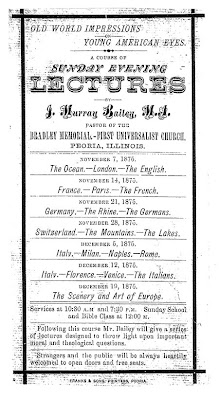
History is a tricky thing. There are so many things we’d like to know, but don’t have information about. And sometimes historical “facts” turn out to be things we thought we knew, but now aren’t so sure about.
Case in point: We know that for a time, our church went by the name “Bradley Memorial.” This name was adopted in memory of Tobias S. Bradley, a prominent member of the church who died in 1867. His widow, Lydia Moss Bradley—also a member of our church—went on to become a businesswoman, philanthropist, and founder of Bradley University.
We thought we knew that the name change to “Bradley Memorial” took place in 1886. After all, it says so in the first published history of our church, written in 1926. And it says so in a handwritten church history found in one of our oldest surviving record books: “On the 19th of May 1886 at a regular Parish meeting it was decided to change the name of the Church to ‘Bradley Memorial’ First Universalist Church.” That history was apparently written around 1900.
A history of Peoria county published in 1902 seems to agree. It mentions the United States General Convention of Universalists held in Peoria in October, 1885, and says that the name of the church was changed to Bradley Memorial “soon after.” So we all agree it was in 1886, right?
However, on the day of our 165th anniversary dinner, an astute observer pointed out that the cover of the program featured a church document dated 1875, which plainly says “Bradley Memorial - First Universalist Church.”
Further investigation has revealed several other instances of the “Bradley Memorial” name being used prior to 1886. These include an 1885 entry in a church record book, the “Thanksgiving Newspaper” published by the ladies of the church in 1882, and a history of Peoria County published in 1880.
So just when was the name changed? And why do so many sources say it was in 1886? I don’t have definitive answers, but I’ll share some thoughts in a future post. In the meantime, feel free to share your comments.
